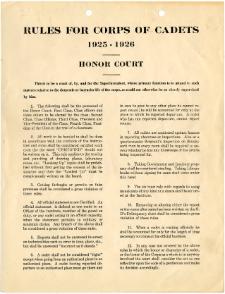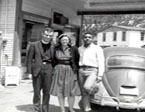VMI Honor System History
Although the administration of the VMI honor system has evolved since the founding of the Institute in 1839, the concept of honor has always been integral to the VMI experience. The ideas expressed in the following excerpt from a recent VMI Honor Code publication would be familiar to a cadet of the 1840's.
"The purpose of the Honor Code is to maintain the high standards traditionally attributed to VMI cadets by seeking to instill in all cadets the desire to conduct themselves according to the code of an honorable cadet, who will NEITHER LIE, CHEAT, STEAL, NOR TOLERATE THOSE WHO DO." All cadets should be able to determine right from wrong, and thus be able themselves to arrive at honorable answers to their questions. The Code is the heart of VMI."The Historical Development of the VMI Honor System:
- 1839 - An honor code has been in existence from the earliest days of the Institute, although it was not published in written form until the early 20th century. Francis H. Smith, VMI's first Superintendent, emphasized the importance of honorable behavior, and it was a tradition firmly established long before the Civil War. Little documentation exists prior to 1908. A rare explicit reference by Smith to the honor code of the 19th century can be found in a letter of January 22, 1868, addressed to the Commandant of Cadets. At this time, VMI was still struggling with the aftermath of the Civil War and was engaged in rebuilding the Institute.
"I deem it of great importance to the tone of the Corps of Cadets to get re-established among them the Code of Honor. Several cadets have brought the subject to my attention."
- 1870 - Although there are no extant documents, 1870 is cited in subsequent years as a turning point in the development of an Honor Court. Early issues of cadet publications such as the student newspaper and yearbook refer to the long history of the honor system. However, an Honor Court did not operate continuously from 1870-1908, and nothing is known of its rules. In the excerpt below, the second part of the last sentence (...and it has functioned ever since) is likely not accurate.
"Probably the greatest asset of a man's character, and one which stands out in every VMI man, is honor. This is a trait not recently acquired, but the product of a rigid system of honor rules which have been respected and obeyed by the corps for years....The honor system is not a novel feature; ever since the foundation of VMI there has been some form of it. From 1839 to 1870 the corps at large controlled such matters as were brought before it. In 1870 the real formation of an honor court took place and it has functioned ever since." (The Cadet, 1925 September 28)
- 1908 - This is the year most frequently cited as the beginning of the Honor Court as it is known today, one which operated continuously from year to year. The Superintendent's Annual Report for 1907-1908 references its development, stating that it is "composed of cadets, members of the upper classes, who are elected by their classmates."
- 1920's - Annual publication of detailed rules became common by the mid-twenties. Early Court regulations often listed both honor violations and lesser transgressions of a disciplinary nature. As the system of cadet government matured and become more formal, other bodies took over non-honor issues. The modern Honor Court addresses only matters pertaining to the Honor Code. View 1925 Honor Court Rules
- 1930's - forward - Although the composition and mechanics of the Honor Court, and the text of the Honor Code rules, continued to be revised, the key components of the honor system have remained unchanged since this time. VMI's system is single sanction - a cadet found guilty of an honor offense is dismissed from the Institute.
.svg)
.png)

